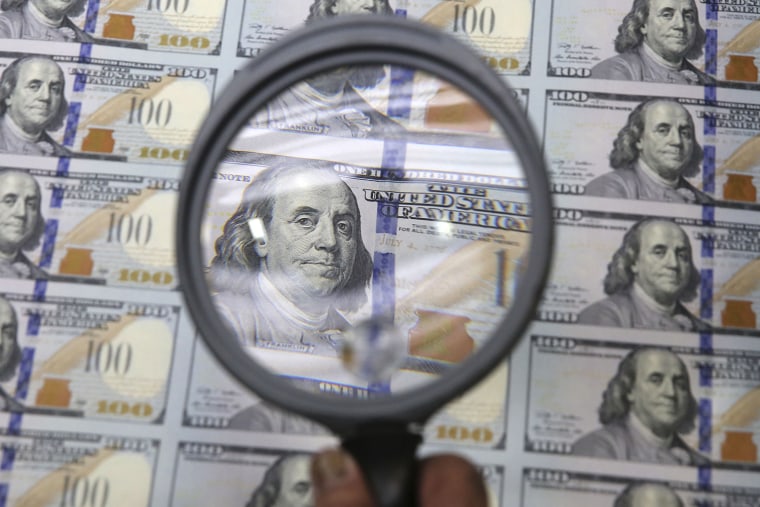To most people, it's a hundred bucks. But to a small cadre of dedicated, if slightly obsessed, collectors, the new $100 bills that go into circulation Oct. 8 are a gold mine.
What excites the collectors most are the new bills' serial numbers. With a new design, the bills' serial numbers will "reset" and start back at number one — and those bucks will be worth big bucks in the right circles.
"I would wager a guess that [the number one] note will bring between $10,000 and $20,000 in uncirculated (mint) condition," said independent dealer Scott Lindquist.
The last time the $100 bill was redesigned, back in the 1990s, that first serial number sold for more than $10,000 on the collector market.
"Early on, they’ll have the highest demand and highest premium. I would anticipate that the first number ones to reach the market will be $7,500 to $10,000,” if not more, said Frederick Bart, a dealer of rare currency. The lowest eight-digit serial numbers — 00000001, 00000002 and so on — will fetch the highest prices.
Combinations of serial numbers — like eight of the same digit, which collectors call "solids" — will probably be worth $3,000 or so in the collectible market, said Bart.
Other popular numbers are “radars,” where the first four numbers mirror the last four numbers, and “ladders,” where the numbers go up sequentially. Among collectors, the collective term for these is “fancy” serial numbers.
In the United States, Bart estimated there are "several hundred dedicated people" willing to shell out five figures for one of the new $100 bills, which still feature the head of Benjamin Franklin.
Jason W. Bradford is one of these. A collector of rare bills since the age of 8, Bradford's day job is running a company that authenticates these sought-after pieces of paper.
"I love low serial notes. One through 100, basically, are very cool… I’ve got several dealers on the lookout" for the new $100 bills once they come out, he said.
"Certainly, if the right note came along… I’d love to have it," he said, even if that meant dropping $10,000.
"I’ve paid more for a piece of currency than I paid for my first house," Bradford said.
Donn Pearlman, spokesman for the Professional Numismatists Guild, an organization of people who make a hobby — and sometimes a living — from the study or collection of coins and paper money, said his priciest purchase wasn't nearly as much. But the nominal value of the bill he paid around $250 for was only 50 cents, a rare note printed during the Civil War era when coins were in short supply.
The new bills have colorful anti-theft features like a wide holographic strip and color-changing ink, and it's the biggest redesign the "Big Ben" has gotten since the "big head" bills, as collectors call them, went into circulation in 1996.
"A major redesign like this in U.S. currency doesn’t happen too often, so it’s kind of a big thing and the new technologies that are going to be on it… are going to be a nice visual," said George Cuhaj, editor of the Standard Catalog of United States Paper Money.
"It's eye-opening to see in person for the first time," said Pearlman, who also collects coins, baseball cards and old comic books as well as rare paper bills. "Every piece of paper money ever printed has a story to tell.
"It’s literally history you can hold in your hands," he said. For instance, in cases when a country grapples with skyrocketing inflation, he said, higher and higher-denomination bills make their way into circulation.
"They're literally one of a kind," Pearlman said, explaining their appeal to hobbyists.
He said his goal is to get one new $100 bill from each of the 12 Federal Reserve banks that issue them. He said he was resigned to paying 50 percent or 60 percent above face value to get a dozen bills in new, uncirculated condition.
“You can look at the history of the United States by looking at its paper money,” he said.
